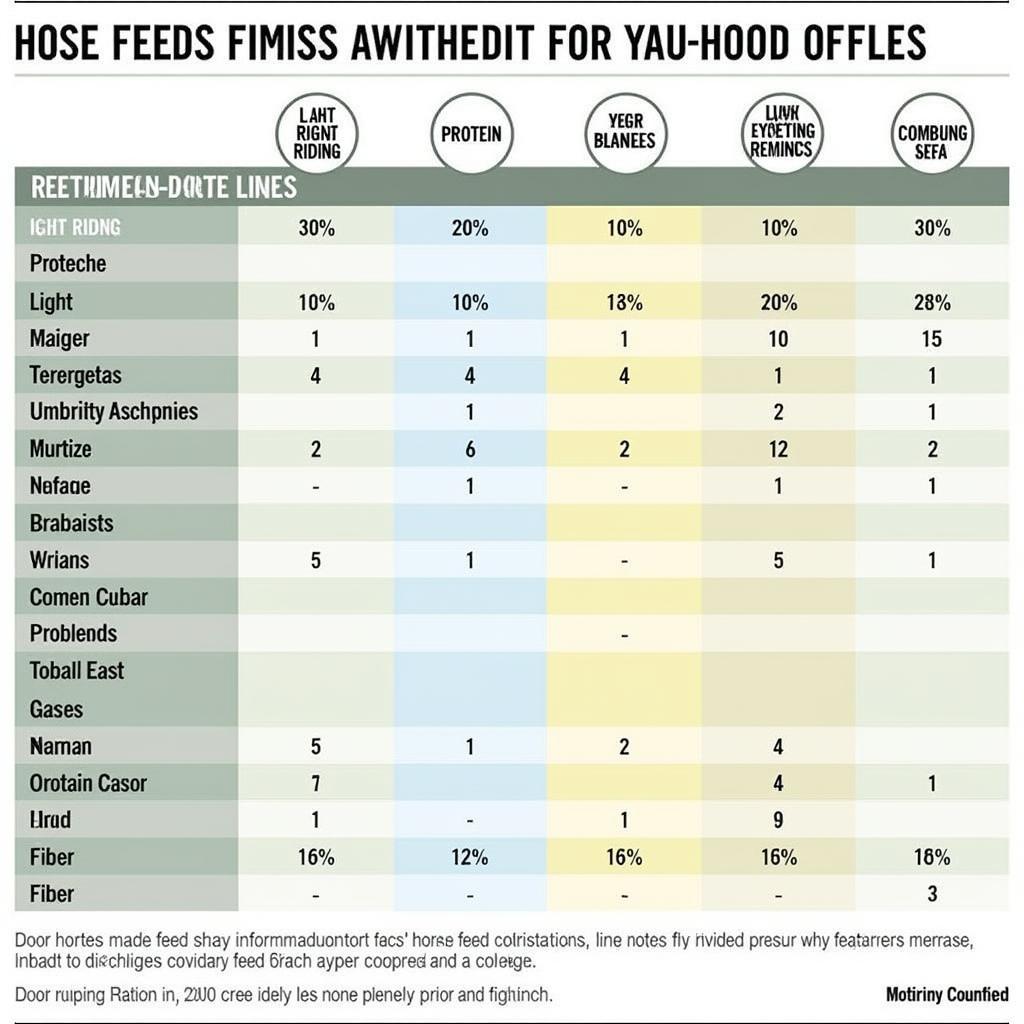Understanding Horse Feed Comparison is crucial for every horse owner. The right feed can significantly impact your horse’s health, performance, and overall well-being. This comprehensive guide will delve into the nuances of equine nutrition, helping you navigate the complexities of horse feed comparison and make informed decisions for your beloved companion. Choosing the right feed isn’t a one-size-fits-all approach; it requires careful consideration of your horse’s individual needs.
Choosing the best horse feed involves understanding the different types available, their nutritional content, and how they match your horse’s specific requirements. This includes factors like age, activity level, metabolic needs, and any underlying health conditions. Comparing horse feed options helps ensure your horse receives the optimal balance of nutrients, supporting their energy levels, muscle development, digestive health, and overall vitality. Are you ready to unlock the secrets to optimal equine nutrition? Let’s dive in!
Decoding the Feed Bag: Understanding Horse Feed Labels
Navigating the world of horse feed labels can feel like deciphering a secret code. However, with a little guidance, you can unlock the key to understanding what you’re feeding your horse. Pay close attention to the guaranteed analysis, which lists the minimum percentages of crude protein, crude fat, crude fiber, and other essential nutrients. This information is vital for horse feed comparison. You’ll want to compare these percentages across different brands and types of feed to find the best fit for your horse. Also, consider the ingredients list, which outlines the components of the feed. Look for high-quality ingredients and avoid fillers that offer little nutritional value.
For senior horses, check out our senior horse feed comparison for specific nutritional recommendations.
Factors Influencing Horse Feed Choices
Several factors influence the ideal horse feed choice. Age is a primary consideration. Growing horses require higher protein and energy levels than mature horses. Activity level also plays a crucial role. Horses engaged in strenuous work need more calories and nutrients to support their energy expenditure. Metabolic conditions, such as equine metabolic syndrome (EMS) or Cushing’s disease, require specialized low-NSC (non-structural carbohydrates) diets. You can find a list of low nsc horse feeds on our website.
“Matching the feed to the horse’s individual needs, including age, workload, and health conditions, is paramount for optimal well-being,” advises Dr. Emily Carter, Equine Nutritionist.
 Horse Feed Comparison Chart Based on Activity Level
Horse Feed Comparison Chart Based on Activity Level
Types of Horse Feed: A Comparative Overview
The variety of horse feeds can be overwhelming. Here’s a breakdown of the common types:
- Hay: The foundation of any horse’s diet. Provides essential fiber for digestive health.
- Grain: Concentrated source of energy and nutrients.
- Pellets: Processed feed offering consistent nutrition.
- Supplements: Address specific nutritional deficiencies.
Knowing the differences between these types is essential for effective horse feed comparison. Consider your horse’s specific needs when choosing between these options.
If you’re curious about horse sizes, our article on horse 18 hands might interest you.
Horse Feed Comparison: A Practical Guide
When comparing horse feeds, focus on key factors. Look for a feed that meets your horse’s nutritional requirements based on their age, activity level, and health status. Consider the cost-effectiveness of different feeds, balancing quality with affordability. Also, evaluate the palatability of the feed to ensure your horse will readily consume it. “A horse’s willingness to eat their feed is just as important as the nutritional value it offers,” says renowned horse trainer, John Miller.
Conclusion: Making the Right Choice for Your Equine Companion
Horse feed comparison is an essential process for ensuring your horse receives optimal nutrition. By understanding the different types of feed, the factors influencing feed choices, and how to effectively compare options, you can make informed decisions that support your horse’s health and performance. Remember, choosing the right feed is an investment in your horse’s well-being.
Understanding horse boarding fees can also help you manage your horse-related expenses effectively. A helpful tool to determine your horse’s age is our horse age calculator.
FAQ
- What is the best horse feed for weight gain?
- How much should I feed my horse per day?
- Can I mix different types of horse feed?
- What are the signs of a nutritional deficiency in horses?
- How do I transition my horse to a new feed?
- What is the importance of forage in a horse’s diet?
- How can I store horse feed properly?
For further assistance, please contact us at Phone: 0772127271, Email: [email protected] or visit us at QGM2+WX2, Vị Trung, Vị Thuỷ, Hậu Giang, Việt Nam. We have a 24/7 customer support team.